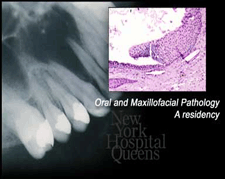المقالات
Condensing Osteitis

Condensing osteitis is a change in the density of the bone that usually occurs as a result of a low-grade infection or chronic irritation to the tissue surrounding the root of a tooth. This irritation or infection is frequently part of the body's response to an infection within the tooth's pulp. Condensing osteitis can also occur in response to deep decay in the tooth, large restorations, injury to the tooth, or low-grade infections at the tooth's root. The change in density can only be seen on a dental X-ray, where it appears as an enlarged white area. It usually occurs in the bone directly adjacent to the infected tooth, or in the bone nearby where there has been a previous infection.
Condensing osteitis can occur at any age, and is frequently more pronounced in younger patients. There is usually no pain or other symptoms associated with this condition. Once the source of the infection is removed, the bone may return to its normal x-ray pattern and density. However, in some cases the bone retains its increased density indefinitely.
Removing the source of the infection typically results in the bone returning to its normal density.
